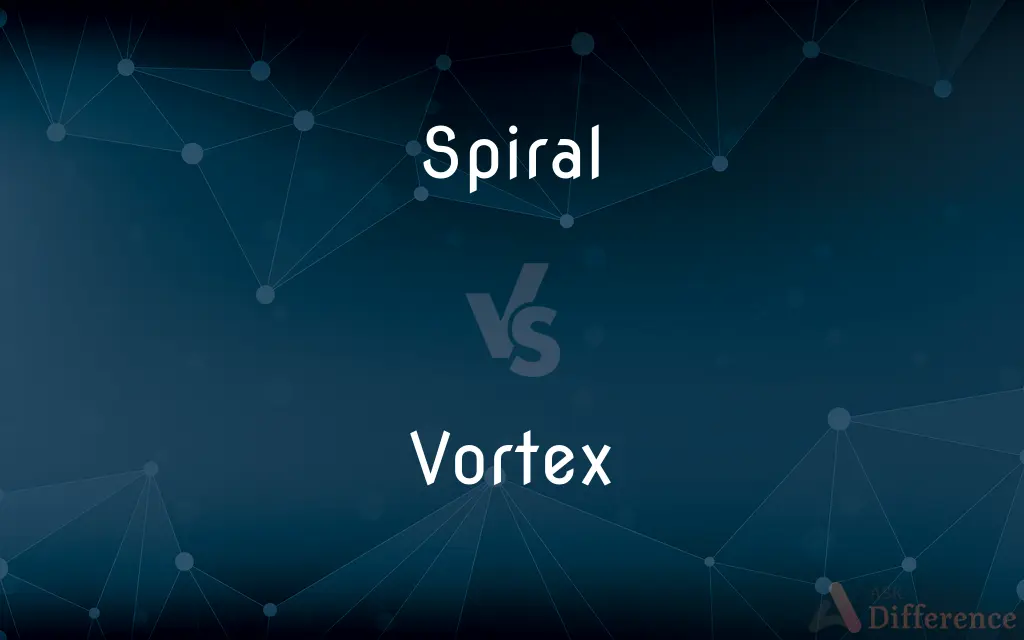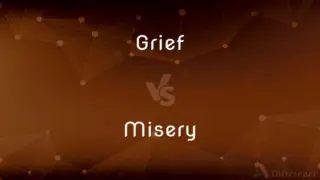Spiral vs. Vortex — What's the Difference?
By Fiza Rafique & Urooj Arif — Updated on April 27, 2024
A spiral is a curve that starts from a point and progressively moves farther away in a circular pattern; a vortex is a dynamic phenomenon where fluids, including air and water, rotate around a core.

Difference Between Spiral and Vortex
Table of Contents
ADVERTISEMENT
Key Differences
A spiral is a geometrical figure where a point moves in a continuous curve around a central point, gradually getting farther from or closer to it. This figure can be seen in various natural and man-made objects like shells, galaxies, or staircases. In contrast, a vortex involves the motion of fluid, such as air or water, spinning rapidly around a void or center. It is an active physical process seen in whirlpools, tornadoes, or even stirred liquids.
Spirals can be static or represented in art and design, emphasizing their aesthetic and symbolic significance. They often represent growth, evolution, or infinity. Vortices, however, are inherently dynamic and represent energy and turbulence. They are frequently analyzed in physics and engineering to understand fluid dynamics and energy patterns.
The structure of a spiral is predictable and can be mathematically defined with formulas relating to angles and distances. A vortex, while it can be studied mathematically under fluid dynamics, is more complex due to its dependence on fluid properties like velocity, pressure, and environmental conditions.
In visual representation, spirals can be drawn or illustrated statically, meaning they do not imply motion by themselves but are recognized by their curled shape. Vortices, though they can be depicted in images, are typically understood through their motion, which is essential to their definition and effects.
Spirals have been used in artwork, architecture, and symbolism throughout human history, denoting concepts of mystery, growth, or the cosmos. Vortices might not be as prevalent in symbolic contexts but are often used to describe powerful natural phenomena or metaphors for chaos and power in literature and media.
ADVERTISEMENT
Comparison Chart
Definition
Geometric curve moving around a central point
Fluids rotating around a core
Representation
Static in art and nature
Dynamic, seen in active fluid movement
Mathematical Model
Defined by precise mathematical formulas
Governed by principles of fluid dynamics
Visual Implication
Does not imply motion
Implies motion and energy
Cultural Significance
Symbolic in art and architecture
Often used to represent chaos or power
Compare with Definitions
Spiral
Seen in both the natural and the man-made world.
Hurricanes viewed from above display a massive spiral formation.
Vortex
Motion around its central axis is critical to its definition.
The vortex in a stirred tea cup can be seen as the tea leaves spin rapidly.
Spiral
Frequently appears in architecture and design.
Spiral staircases are a space-saving and visually appealing element in buildings.
Vortex
A flow phenomenon where fluids rotate around a void.
The water going down a drain often forms a vortex.
Spiral
Can be plotted mathematically using specific formulas.
Archimedean and logarithmic are two types of mathematical spirals.
Vortex
Essential in studies of fluid dynamics.
Aircraft designers study vortices to understand how air moves around wings.
Spiral
A curve that winds around a fixed center point at a continuously increasing or decreasing distance.
The nautilus shell is a classic example of a natural spiral.
Vortex
Represents powerful natural forces like tornadoes or whirlpools.
Tornado chasers analyze the vortex to predict tornado paths.
Spiral
Symbolizes concepts such as growth or evolution.
The spiral in ancient petroglyphs symbolizes the journey of life.
Vortex
Often depicted in media as a symbol of chaos or instability.
The movie used a giant vortex as a metaphor for the character's emotional turmoil.
Spiral
In mathematics, a spiral is a curve which emanates from a point, moving farther away as it revolves around the point.
Vortex
In fluid dynamics, a vortex (plural vortices/vortexes) is a region in a fluid in which the flow revolves around an axis line, which may be straight or curved. Vortices form in stirred fluids, and may be observed in smoke rings, whirlpools in the wake of a boat, and the winds surrounding a tropical cyclone, tornado or dust devil.
Spiral
A curve on a plane that winds around a fixed center point at a continuously increasing or decreasing distance from the point.
Vortex
A whirling mass of fluid or air, especially a whirlpool or whirlwind
A swirling vortex of emotions
We were caught in a vortex of water
Spiral
A three-dimensional curve that turns around an axis at a constant or continuously varying distance while moving parallel to the axis; a helix.
Vortex
A whirling mass of water or air that sucks everything near it toward its center.
Spiral
Something having the form of such a curve
A spiral of black smoke.
Vortex
A place or situation regarded as drawing into its center all that surrounds it, and hence being inescapable or destructive
A vortex of political infighting.
A vortex of despair.
Spiral
(Printing) A spiral binding.
Vortex
A whirlwind, whirlpool, or similarly moving matter in the form of a spiral or column.
Spiral
The course or flight path of an object rotating on its longitudinal axis.
Vortex
(figuratively) Anything that involves constant violent or chaotic activity around some centre.
Spiral
A continuously accelerating increase or decrease
The wage-price spiral.
Vortex
(figuratively) Anything that inevitably draws surrounding things into its current.
Spiral
Of or resembling a spiral.
Vortex
(historical) A supposed collection of particles of very subtle matter, endowed with a rapid rotary motion around an axis which was also the axis of a sun or planet; part of a Cartesian theory accounting for the formation of the universe, and the movements of the bodies composing it.
Spiral
Circling around a center at a continuously increasing or decreasing distance.
Vortex
(zoology) Any of numerous species of small Turbellaria belonging to Vortex and allied genera.
Spiral
Coiling around an axis in a constantly changing series of planes; helical.
Vortex
(chemistry) To mix using a vortex mixer
Spiral
(Printing) Relating to or having a spiral binding
A spiral notebook.
Vortex
A mass of fluid, especially of a liquid, having a whirling or circular motion tending to form a cavity or vacuum in the center of the circle, and to draw in towards the center bodies subject to its action; the form assumed by a fluid in such motion; a whirlpool; an eddy.
Spiral
To take a spiral form or course.
Vortex
A supposed collection of particles of very subtile matter, endowed with a rapid rotary motion around an axis which was also the axis of a sun or a planet. Descartes attempted to account for the formation of the universe, and the movements of the bodies composing it, by a theory of vortices.
Spiral
To rise or fall with steady acceleration.
Vortex
Any one of numerous species of small Turbellaria belonging to Vortex and allied genera. See Illustration in Appendix.
Spiral
To cause to take a spiral form or course.
Vortex
The shape of something rotating rapidly
Spiral
(geometry) A curve that is the locus of a point that rotates about a fixed point while continuously increasing its distance from that point. Category:en:Curves
Vortex
A powerful circular current of water (usually the resulting of conflicting tides)
Spiral
(informal) A helix.
Spiral
A self-sustaining process with a lot of momentum involved, so it is difficult to accelerate or stop it at once.
Spiral
(rail) A section of track that forms a circle and crosses over itself, used for gaining height in mountainous territory.
Spiral
Helical, like a spiral.
Spiral
(intransitive) To move along the path of a spiral or helix.
Spiral
(transitive) To cause something to spiral.
Spiral
To increase continually.
Spiral
Winding or circling round a center or pole and gradually receding from it; as, the spiral curve of a watch spring.
Spiral
Winding round a cylinder or imaginary axis, and at the same time rising or advancing forward; winding like the thread of a screw; helical.
Spiral
Of or pertaining to a spiral; like a spiral.
Spiral
A plane curve, not reëntrant, described by a point, called the generatrix, moving along a straight line according to a mathematical law, while the line is revolving about a fixed point called the pole. Cf. Helix.
Spiral
Anything which has a spiral form, as a spiral shell.
Spiral
A plane curve traced by a point circling about the center but at ever-greater distances from it
Spiral
A curve that lies on the surface of a cylinder or cone and cuts the element at a constant angle
Spiral
Ornament consisting of a curve on a plane that winds around a center with an increasing distance from the center
Spiral
A structure consisting of something wound in a continuous series of loops;
A coil of rope
Spiral
Flying downward in a helical path with a large radius
Spiral
To wind or move in a spiral course;
The muscles and nerves of his fine drawn body were coiling for action
Black smoke coiling up into the sky
The young people gyrated on the dance floor
Spiral
Form a spiral;
The path spirals up the mountain
Spiral
Move in a spiral or zigzag course
Spiral
In the shape of a coil
Common Curiosities
Where might one commonly see a spiral?
Spirals are common in nature, in structures like shells, flowers, and galaxies, as well as in man-made objects like spiral staircases.
Can a vortex be considered a type of spiral?
While a vortex may appear spiral-like, it is fundamentally different due to its dynamic nature and fluid involvement.
What causes a vortex to form?
Vortices form due to differences in fluid velocity and pressure, which can be natural, like in tornadoes, or induced, like stirring a liquid.
What is the key difference between a spiral and a vortex?
The key difference is that a spiral is a static geometric pattern, whereas a vortex is a dynamic fluid motion.
How do engineers study vortices?
Engineers use principles of fluid dynamics and various modeling tools to study the properties and effects of vortices.
Why are spirals significant in many cultures?
Spirals are often seen as symbols of eternity, evolution, and the cosmos, reflecting their endless, cyclic nature.
Can a vortex be static?
No, by definition, a vortex is a movement; without motion, it would not be a vortex.
How can vortices affect weather patterns?
Vortices such as cyclones can significantly impact weather, causing storms and influencing climate patterns.
Is there a cultural or mythological significance to vortices?
In many cultures, vortices are associated with power and mystery, often depicted as portals or gateways in mythological stories.
What mathematical principles are used to define a spiral?
Spirals can be defined using polar coordinates with equations that relate the radius to the angle.
Are spirals found in everyday technology?
Yes, spirals are used in technology, from the design of compact spiral staircases to the coils in heating elements.
What are some practical applications of understanding vortices?
Understanding vortices is crucial for applications in meteorology, aviation, and marine engineering to enhance safety and efficiency.
How do spirals and vortices differ in visual arts?
Spirals in visual arts are used to create patterns and symbols, often representing harmony and continuity, whereas vortices might be used to convey motion and energy.
What type of spiral is found in galaxies?
Many galaxies, including the Milky Way, are classified as spiral galaxies, characterized by their flat, rotating disk of stars and spiral arms.
What role do spirals play in modern mathematics?
Spirals are studied in fields like calculus and geometry to understand their properties and applications in real-world scenarios.
Share Your Discovery

Previous Comparison
Grief vs. Misery
Next Comparison
Yabby vs. CrayfishAuthor Spotlight
Written by
Fiza RafiqueFiza Rafique is a skilled content writer at AskDifference.com, where she meticulously refines and enhances written pieces. Drawing from her vast editorial expertise, Fiza ensures clarity, accuracy, and precision in every article. Passionate about language, she continually seeks to elevate the quality of content for readers worldwide.
Co-written by
Urooj ArifUrooj is a skilled content writer at Ask Difference, known for her exceptional ability to simplify complex topics into engaging and informative content. With a passion for research and a flair for clear, concise writing, she consistently delivers articles that resonate with our diverse audience.
















































